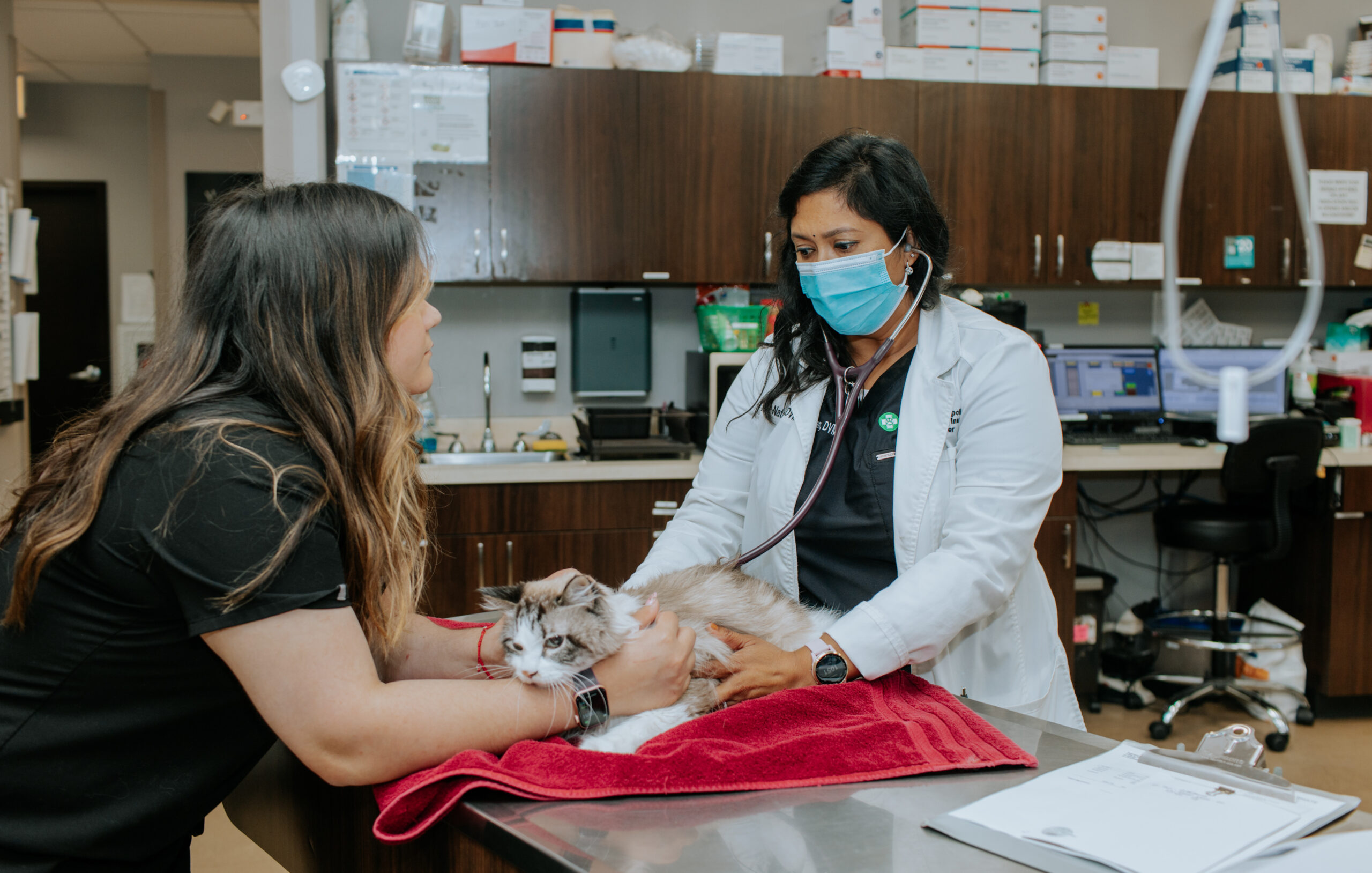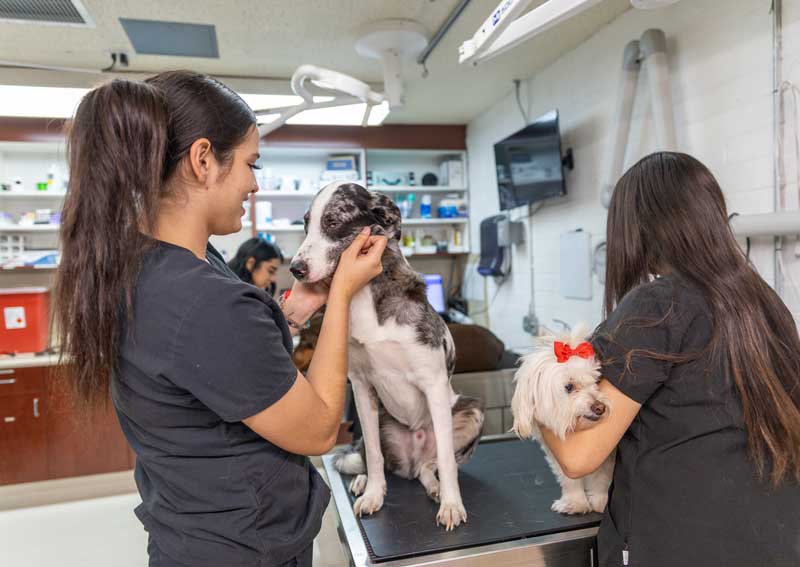Why Animal Rehab Is Critical: the Conveniences of Veterinarian Services for Your Pet's Recovery
Animal rehabilitation is a crucial component of recovery for family pets encountering injuries or handicaps. Veterinary services offer vital support through tailored rehabilitation strategies that deal with individual needs. These plans typically consist of pain monitoring, physical therapy, and nutritional assistance. Understanding the numerous elements of animal rehab can illuminate its value in improving recovery results. What specific advantages do these services supply, and how can they transform a pet's healing journey?
Understanding Pet Recovery
Pet rehabilitation includes a variety of restorative techniques focused on restoring the health and wellness and capability of hurt or handicapped pets. This field integrates various strategies, consisting of physical treatment, hydrotherapy, and occupational therapy, customized to meet the details requirements of each pet. Rehabilitation professionals analyze an animal's condition, establishing customized therapy strategies that might include workouts to strengthen muscular tissues, enhance wheelchair, and enhance total well-being. The procedure not only concentrates on physical recovery but also addresses psychological and behavior facets. Animals typically experience stress and anxiety and stress and anxiety complying with an injury, making mental wellness considerations necessary in recovery. By creating a helpful atmosphere, therapists can help pets reclaim their self-confidence and adapt to their new situations. With routine sessions, pets can experience considerable renovations, eventually leading to a much better lifestyle. Generally, recognizing pet recovery highlights its relevance in advertising recuperation and enhancing the bond between family pets and their proprietors.
The Role of Discomfort Monitoring in Healing
Exactly how crucial is efficient discomfort management in the recuperation of injured pets? It plays a vital function in facilitating recovery and improving the overall health of pet dogs. Proper discomfort monitoring not just relieves discomfort yet additionally advertises movement, making it possible for animals to take part in rehabilitation tasks necessary for recuperation. When pain is successfully managed, pets tend to react favorably to therapy, bring about quicker recovery outcomes.Veterinarians use numerous methods to evaluate and attend to discomfort, consisting of drugs, acupuncture, and different treatments. By tailoring discomfort administration methods to the private requirements of each animal, vets can guarantee that pet dogs remain calm and participating throughout their recovery trip. Decreasing pain helps minimize anxiety, which can prevent recovery and lengthen healing times. To summarize, effective discomfort administration is important for enhancing the recuperation procedure and improving the lifestyle for hurt animals.
Physical Therapy Strategies for Pets
Countless physical therapy methods are readily available to help in the recovery of animals recovering from injuries or surgical procedures (emergency vet bellingham). These methods can enhance mobility, alleviate pain, and promote recovery. Restorative exercises, as an example, help reinforce muscle mass and boost joint function, allowing animals to restore their physical capacities slowly. Hand-operated therapy, which consists of massage therapy and mobilization, can minimize stress and improve blood circulation, adding to a quicker recovery.Other strategies such as passive series of movement exercises encourage joint adaptability and minimize rigidity. Furthermore, electric stimulation treatment may be utilized to boost nerves and muscular tissues, promoting healing and pain relief.Veterinary professionals usually customize these techniques to every pet's specific needs, guaranteeing a detailed rehabilitation strategy. By applying these physical therapy techniques, pet dogs can experience enhanced lifestyle and an extra effective recovery from their conditions. The combination of these methods right into rehabilitation programs is vital for optimal recovery end results
Benefits of Hydrotherapy for Recovery
Hydrotherapy uses considerable benefits in pet recovery, specifically in boosting flexibility. This water-based therapy promotes pain relief while giving convenience to injured or recuperating pet dogs. Additionally, it facilitates strength-building workouts that contribute to overall physical recovery.
Improved Mobility Improvement
As animals recuperate from injuries or surgeries, enhanced wheelchair usually becomes a key objective of their rehab. Hydrotherapy acts as a valuable tool in accomplishing this objective. Through water-based workouts, pets can engage in low-impact activities that facilitate joint flexibility and strengthen muscles without the tension of weight-bearing tasks. The buoyancy of water supports their bodies, permitting for boosted variety of activity and mobility improvement. Additionally, hydrotherapy urges far better equilibrium and coordination, which are essential for bring back regular motion patterns. Regular sessions can result in significant progress in an animal's physical capacities, ultimately improving their lifestyle. This method not only help in healing but also promotes a more energetic and fulfilling way of life post-rehabilitation.
Pain Alleviation and Comfort

Remedy for discomfort is an essential aspect of animal recovery, and hydrotherapy considerably contributes to this procedure. By making use of water's buoyancy, hydrotherapy decreases joint stress and relieves discomfort during motion. This healing approach supplies a calming environment where pets can take part in mild exercises without the full weight of their bodies impacting their recovery. The warm water promotes blood circulation, promoting recovery while additionally encouraging relaxation. Furthermore, hydrotherapy sessions can be tailored to satisfy the details needs of the animal, guaranteeing perfect comfort. As pets experience minimized discomfort and enhanced convenience degrees, their overall desire to join rehabilitation activities commonly improves, bring about an extra effective healing journey. Hydrotherapy serves as a vital tool in improving discomfort relief and convenience during rehabilitation.
Stamina Building Exercises
Strength-building workouts play a vital function in the recovery process, with hydrotherapy offering distinct advantages. This kind of therapy makes use of water resistance to enhance muscle strength without placing extreme stress on the joints. The buoyancy of water sustains the family pet's weight, enabling safer activity and enhanced variety of movement. In addition, hydrotherapy can improve cardio health and wellness and promote overall health and fitness, aiding in faster recuperation from injuries or surgical procedures. The controlled atmosphere likewise reduces the danger of reinjury, making it an ideal choice for family pets needing rehabilitation. Routine hydrotherapy sessions can bring about visible renovations in mobility, strength, and endurance, eventually improving the family pet's lifestyle and ability to go back to normal tasks.
Importance of Custom-made Rehab Plans
Customized rehab strategies are necessary for resolving the one-of-a-kind requirements of each pet, ensuring individualized treatment approaches. These plans enable effective progression monitoring and necessary modifications, fostering optimal healing end results. Additionally, a holistic strategy can improve the overall health of the animal, advertising an extra extensive rehab experience.
Individualized Treatment Approaches
While several rehabilitation programs take on a one-size-fits-all method, the unique needs of each animal require individualized treatment prepare for optimal recuperation. Personalized rehabilitation plans consider different aspects, consisting of the pet's types, age, case history, and details injuries or problems. By customizing treatments, veterinarians can address each animal's distinct difficulties, maximizing the performance of the rehab process. Embellished plans may include different methods such as physical treatment, hydrotherapy, and restorative workouts, making sure that the treatment lines up with the pet's capacities and progression. Additionally, tailored approaches foster a stronger bond in between the animal and the caretaker, promoting an extra engaging and encouraging healing atmosphere. Ultimately, personalized treatment is vital for achieving finest possible results in pet recovery.
Progress Tracking and Adjustments

Holistic Healing Techniques
Alternative recuperation methods are crucial for effective animal rehab, as they stress the importance of customized therapy strategies tailored per animal's particular requirements. This method considers the physical, emotional, and environmental factors impacting healing. Customized rehabilitation strategies may include a mix of physical therapy, nutritional therapy, and behavioral modifications. By dealing with these diverse elements, vets can improve the total health of the animal and advertise a quicker healing. Such customized methods facilitate a deeper understanding of the pet dog's distinct challenges, leading to much more reliable treatments. Inevitably, all natural healing techniques not just boost physical wellness yet also add to the animal's mental and emotional security, making sure a detailed rehabilitation experience.
The Effect of Nutrition on Recovery
Nutrition plays a crucial duty in the healing procedure for restoring pets, usually identifying the rate and performance of recovery. A well-balanced diet offers the needed nutrients that sustain cells repair work, increase the body immune system, and enhance total vitality. Healthy protein is specifically essential, as it aids in muscle mass rebuilding and healing from injuries. Vital fats, vitamins, and minerals also contribute to decreasing swelling and advertising ideal mobile function.Veterinarians frequently emphasize the importance of customized nutrition plans, thinking about each animal's certain requirements, age, and health condition. Correct hydration is just as essential, as fluids assist in vitamins and mineral absorption and help in detoxification. By ensuring that animals get suitable nutrition, caretakers can greatly boost their possibilities of an effective recuperation, resulting in far better long-lasting health end results. Ultimately, nourishment functions as a fundamental aspect in the rehab journey, sustaining pets in regaining toughness and resilience post-injury or ailment.
Success Stories: Family Pets Who Thrived After Recovery
Successful rehab tales are plentiful, showcasing the resilience of pet dogs who have overcome considerable challenges. Take, as an example, Bella, a gold retriever who experienced severe injuries from an automobile crash. With committed vet care and website a thorough rehabilitation program, she reclaimed her movement and went back to her lively self, much to her owner's joy. Max, a senior pet cat identified with joint inflammation, experienced exceptional enhancement via a combination of physical treatment and pain monitoring. His newfound dexterity enabled him to appreciate his favored sunbathing places once more. Another motivating case is that of Coco, a saved greyhound that overcame stress and anxiety via behavior modification and socialization methods, allowing her to flourish in her new home. These success stories exhibit the transformative power of pet recovery, emphasizing that with the right assistance, pet dogs can not just recoup yet lead satisfying lives, enhancing the bonds they share with their households.
Regularly Asked Concerns
For how long Does the Rehabilitation Process Normally Take for Pet Dogs?
The rehab procedure for animals generally differs based on the injury or condition, ranging from a couple of weeks to a number of months. Specific progress, treatment type, and commitment to workouts significantly affect the general duration of healing.
Exist Any Kind Of Risks Related To Pet Recovery?
Pet rehab may lug dangers such as worsening of injuries, incorrect strategies leading to pain, or inadequate monitoring during healing. These elements can prevent progress and impact the general effectiveness of the rehab procedure.

Can All Pets Take Advantage Of Recovery Solutions?
Not all animals may call for rehabilitation, however many can profit significantly. Recovery solutions can improve flexibility, minimize pain, and enhance total health, particularly for those recouping from injuries, surgical treatments, or persistent problems.
Exactly How Can I Prepare My Pet for Rehab Sessions?

What Signs Show My Animal Requirements Recovery?
Indicators indicating a family pet may require rehabilitation include problem strolling, limping, lowered task levels, unwillingness to leap, or indicators of pain. Observing these actions can motivate owners to look for expert examination and treatment for their family pets.